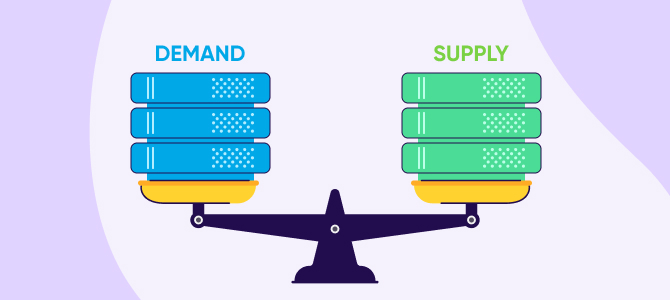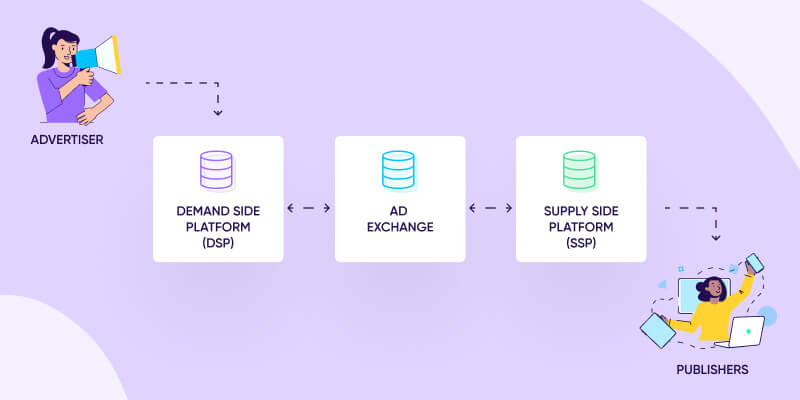
Supply-side platform (SSP)
A technology platform or software that manages a publisher’s ad impression inventory across multiple ad exchanges. SSPs are effective marketing tools because they automate and optimize the sales of a publisher’s media space, helping to fill it with ads and generate revenue.
What are supply-side platforms (SSPs)?
SSPs help publishers automate the selling, managing, and optimizing of their ad inventory on the web and on mobile devices.
Before SSPs, publishers needed to manually manage and sell their ad space; however, this left them unable to scale their selling processes and guarantee that ad spaces were filled.
At first, publishers used supply-side platforms to fill leftover inventory at lower prices. However, today SSPs are responsible for the programmatic selling of all ad inventory.
How SSPs work
Did you ever stop and think about the ads Google serves you?
While it seems like Google knows you a little too well, it’s actually sharing your user behavior with both the advertiser (DSP) and the publisher (SSP), so they can serve you the right ads — and all in real-time.
SSPs facilitate the relationship between the publisher and the advertiser. They can send available ad impressions to as many potential buyers as possible with the aim of selling the publisher’s inventory at the best price.
The functionality of the SSP offers advertisers the chance to purchase these ad impressions across a variety of different publisher sites, which are all targeted to specific users, and based on users’ key online identifiers and behaviors.
Based on a publisher’s content and visitors, advertisers will bid to place their ads on those sites. This happens because the publisher’s SSP offers its available impressions. The advertiser’s DSP will analyze these in real-time — and the result is perfectly placed ads served to the right user.
SSPs and DSPs

DSPs are the inverse of SSPs. DSPs are employed by advertisers that want to buy ad inventory (the demand), and SSPs are used by publishers with ad space to sell (the supply).
SSPs and DSPs connect via ad exchanges, where DSPs bid on ad inventory in an automated, auction-style transaction. SSPs allow publishers to sell their ad inventory across various ad exchanges, while DSPs allow advertisers to purchase across several ad exchanges at once.
Mobile SSPs
These are part of an already existing SSP ecosystem and are usually not a standalone program. Therefore, when referring to mobile SSPs, you are mostly referring to the function in your typical SSP that handles your mobile inventory.
Mobile SSPs are connected to mobile ad exchanges, which is where app publishers and app developers offer their available mobile impressions to advertisers.
3 benefits of SSPs
The advantages of a supply-side platform are many and start with the most obvious one — the automation of what was once a manual and cumbersome process. Although SSPs will vary depending on which platform you choose, here are three more universal benefits of SSPs:
Boosting ad fill rates

First and foremost, using a supply-side platform should automatically pump up your ad fill rate.
The number of ad spaces demonstrates a publisher’s fill rate. And since fill rates are linked directly to revenue, it is important to remember that the process of generating revenue begins when a user is served an ad and then clicks on its CTA (call to action). So, boosting your fill rate is pretty important.
Supply-side platforms guarantee that your available ad spaces are sold to the highest bidder. Ultimately, this will bring in more revenue per space. Because SSPs encourage more advertisers’ participation, every instance of space-filling is potentially perfectly optimized.
Limiting impression fatigue
The digital marketplace is crowded, and, as a result, the likelihood that users will frequently see the same ad content has increased.
Serving the same ad impression to your users can negatively affect the impact of your impressions. Ad impression fatigue is real, and who among us hasn’t avoided content from an advertiser guilty of serving us ad content we have already seen?
Because a supply-side platform collaborates with a DSP to determine the cap on your ad frequency, you can limit the number of similar or identical ad impressions served to a user on your site.
SSPs help publishers avoid ad impression fatigue, ensuring the impact of their impressions and their revenue-generating potential.
Giving publishers more control over pricing
SSPs allow publishers to set price floors for their impressions, which has freed publishers from having to fill ad space at any (and usually low) price.
In other words, SSPs enable publishers to set their price standards, ensuring that ad space is filled and publishers are paid fairly for those impressions.
The programmatic advertising ecosystem
Programmatic advertising is the automation of the buying and selling of digital advertising space. The programmatic advertising ecosystem connects publishers to the ad exchange and to the valuable ads they are looking to fill their space with, and brings together real-time bidding, SSPs, and DSPs.
Real-time bidding (RTB)
RTB occurs when advertisers via a DSP bid automatically for ad impressions offered via an SSP from a publisher.
The bidding happens in a fraction of a second, between the time a prospect lands on a page and that page has fully loaded. During those milliseconds, the SSP manages the bidding, then the winner’s ad is served to the user on the publisher’s site – based on budgets and demographic criteria.
Programmatic direct
This is the non-auction model in programmatic advertising. Unlike RTB, programmatic direct is when publishers sell their ad space directly to advertisers for a negotiated price and for a fixed amount of time.
The benefit of programmatic direct is that publishers are guaranteed premium ads served on their web pages. In the programmatic-direct model, both publisher and advertiser negotiate a CPM (cost per mille or thousand) that is fair for both sides.
An excellent example of a case where programmatic direct is preferable to real-time bidding – would be a popular mommy blog selling ad space to a high-end stroller company.
The publisher has ad space that relates to the advertiser’s targeted audience, and the advertiser is guaranteed a certain number of impressions — a win-win for both parties.
How to choose the right SSP
Understanding how SSPs work is important, but knowing which supply-side platform is right for you — is essential.
Here are four questions to consider when looking for the right SSP:
Do I need a third-party SSP or a custom SSP?
Before asking any other question, you must first decide what type of SSP you need, a third-party or custom SSP.
Third-party SSP
These are precisely what they sounds like. Third-party SSPs are ready-made software and ad technology platforms that are as simple as plugging into existing infrastructure, and BAM, you’re already on your programmatic advertising journey!
Which existing third-party SSP you choose will depend on what your needs are, your strategy, your budget, and your targeted audiences.
The available SSPs on the market today each have their unique features, fees, and customer ratings, so it’s easier to make an informed decision. The advantage of taking this route on your programmatic journey is that once you know your needs, choosing the right platform and using it is easy-peasy, literally, plug in and go.
The cons of using a third-party SSP start with your data, and the fact that your intellectual property will not belong to you. Additionally, you’ll be paying fees and commissions for your third-party software, and while you can explore options, you cannot fully customize an existing SSP, which will place a limit on your value in the market.
Custom SSPs
These are platforms built from scratch and uniquely engineered to meet your ad space inventory needs.
The perks of building your custom supply-side platform are many:
First, you will own and maintain complete control of the platform, your intellectual property, and your data. A custom SSP will also allow you to create your specific product roadmap and build unique features to optimize your inventory, removing any limitations to your market value.
While a custom SSP means you will save money in the long run because you will not have any third-party fees or commissions, on average, the upfront costs of a custom platform far outprice third-party software.
Does it think about the publisher’s users?
An SSP that offers many options is preferable to one that does not.
If the users are unsatisfied, publishers have much bigger problems than prices and rates.
Many publishers like to experiment with different formats to understand what is most appropriate for their users. Choosing an SSP with more options allows publishers the freedom to test and explore how and when to serve their valuable impressions to a user – so that they can increase the likelihood of a click and convert.
Does it have multiple demand sources?
The goal of a publisher is to sell as much of their ad inventory at the best possible price. But to do that, publishers need buyers who are willing to compete for the space.
As a publisher, you need to connect to as many top-quality demand-side platforms, ad exchanges, and ad networks as possible.
Advertisers or ad space buyers are your demand source, so looking for an SSP with access to various demand sources provides you (as the publisher) with the buyers who are potentially willing to compete for your valuable ad space.
Does it offer analytics and reporting?
One of the reasons you use an SSP is to improve the yield optimization of your advertising space inventory on mobile apps and websites.
An SSP with an analytics and reporting interface helps publishers understand and track how their inventory performs, what their fill rates are, and their number of clicks and impressions.
In understanding how ones’ inventory works, publishers can then monetize their ad impressions automatically and to scale.
The 8 best SSPs on the market right now
Programmatic advertising is growing remarkably and is thought to be the future of digital and online advertising. Therefore, it is critical for publishers to understand the various programmatic platforms available to them.
So, here are eight of the best SSPs on the market right now:
- Google Ad Manager
- OpenX
- Magnite
- Sovrn
- PubMatic
- InMobi
- SmartyAds
- Index Exchange
Key takeaways
SSPs and the programmatic advertising ecosystem are full of technical jargon, which evolves as fast as the industry itself. But don’t feel confused. Just remember the following:
- SSPs the digital advertising wave of the future. They automate and optimize the selling of a publisher’s media space, helping to fill it with ads and generate revenue.
- SSPs facilitate the relationship between the publisher and the advertiser, ensuring ads are served to the correct user on the appropriate sites.
- SSPs boost ad fill rates, limit ad impression fatigue, and give publishers more control over pricing.
- If you know what type (custom or third-party) and what to ask, you know which SSP is perfect for you!




